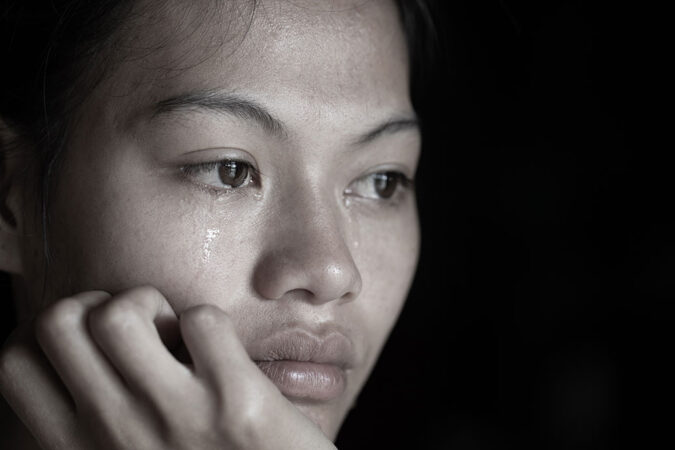Prevention programs can help reduce teen dating violence
At least one in three teens may find themselves in abusive relationships at some point

Not all love stories are happy ones. Different forms of teen dating violence affect between one-eighth and one-third of U.S. teens, data show.
Mixmike/ E+/ Getty Images Plus
“I saw all the good things in the very beginning,” says Erika Kura. As a high school freshman, she felt flattered when a popular senior boy said she was beautiful. “He could make me laugh, and he was charming,” she recalls.
After they were in a relationship, Kura began to see the bad. The boy pressured her to do sexual things, even if she felt unsure or said no. Sometimes, she felt she had to give in. If she didn’t, for example, he might leave her somewhere without a ride home. At times, he got her drunk and then took advantage of her. At other times the older teen insulted her by comparing her body to others’. Or, he deliberately let her see him snuggling up with another girl.
Her abuser wheedled his way into her social group. He cozied up to her mother and brother, too. Kura felt she couldn’t tell others how he treated her, because they all liked him. And if she tried to talk with him about these problems, the boy blamed her. Or, he acted like she was crazy. Afterward he’d act sweet for a while. Then the abuse resumed.
“This messes with you,” Kura says. For a while she had an eating disorder. She even thought about suicide. After about a year and a half, she broke up with the older teen. For years afterward, though, he kept trying to get back into her life. She wound up going to the police. The young man’s arrest for an unrelated crime finally ended his attempts to contact her.
Now in her early 30s, Kura is a graduate student at Case Western Reserve University in Cleveland, Ohio. There, she studies public health and social work. Her goal is to prevent dating violence and to help others who’ve been hurt.
“People want to assume that it won’t happen to them,” Kura says. Statistics say otherwise. Roughly one in 12 U.S. teens experienced physical or sexual dating violence in the past year. That figure, from the U.S. Centers for Disease Control and Prevention, combines data for girls and boys. Globally, almost one in four girls aged 15 to 19 already has faced physical or sexual violence if they’ve had an intimate partner, the World Health Organization estimates.
Add in other forms of abuse, and the numbers go up. About one in three people between the ages of 14 and 20 has been hurt by dating violence, says a U.S. Department of Education fact sheet from 2015. Roughly an equal share of teens have hurt others. But many cases aren’t reported, Kura says. So the real numbers may be much higher. Another name for teen dating violence is “adolescent relationship abuse.”
In any form, teen dating violence will hurt someone’s mental and physical health. And it is far too common. Many different programs aim to prevent dating violence. Some may work better than others. Recent research looks at which features boost a program’s chances to reduce harm for teens. The better any prevention program is, the healthier teens’ relationships can be.
If you suspect you may be in an unhealthy relationship or something doesn’t feel right:
Call 1-866-331-9474
Text “LOVEIS” to 22522.
Use love is respect’s live chat.
Rooted in control
Teens of any gender can be the targets of dating violence. And teens of any gender can harm others. The problem affects both heterosexual and LGBTQ+ teens. (The letters stand for lesbian, gay, bisexual, transgender and queer or questioning.)
Dating violence takes many forms. Physical violence may include hitting, slapping, punching, shoving or other attacks. Restraining someone or threatening them with harm is physical violence, too. Examples of sexual dating violence include unwanted touching, kissing or other sexual contact or intercourse. Sometimes abusers pressure others to do things and make them feel like they have no real choice. Other times abusers may use force or do things when the other person is drunk or otherwise could not consent.
Verbal dating violence can be name calling, nasty comments to or about a person or other attacks with words. Manipulative and controlling behaviors fall into the category of psychological dating violence. Then there’s cyber violence. If someone shares private photos of another person online without their permission, for example, that is cyber dating violence. So is making rude online comments or spreading hurtful rumors about someone on social media.
Boys are “no more likely to be violent than girls” in dating relationships, says Chuka Emezue. He’s a public health expert at Rush University’s College of Nursing in Chicago, Ill. “However, the type of violence they perpetrate differs.” In the United States, girls tend to use physical abuse more. Boys, he notes, are more likely to commit sexual and psychological violence.
Whatever its form, teen dating violence is “rooted in power control,” explains Maya Ragavan. She’s a pediatrician in Pennsylvania at the University of Pittsburgh School of Medicine and UPMC Children’s Hospital of Pittsburgh. Her research deals with how to prevent dating violence and domestic violence.
Bruises, broken bones or other physical injuries may be easy to see. Damage to someone’s emotional and mental health will be less obvious — yet still very harmful, says Laura Voith. She’s a social welfare expert at Case Western.
Abuse in adolescent relationships can shape how young people see themselves. It also can affect how they get along with family and other people, and how well they do at school or in other activities. People hurt by teen dating violence also are at higher risk for substance abuse, suicide, depression or risky sexual behavior, Voith notes. And experiencing violence as a teen raises the odds of having it happen again later, she says.

Prevention programs can help
So what’s the answer? Start by knowing what resources are out there to help people who find themselves in an abusive relationship, Voith says. (See “What can you can do?” below.)
Even better would be preventing any harm in the first place. Ideally, she says, prevention programs should aim to help both potential targets of abuse and those who would commit it. “From my perspective,” Voith says, “if you don’t really try to engage folks who have used violence or that have harmed others in a meaningful way, the problem will continue.”
Kura wonders if it would have helped if she had learned about warning signs for dating violence when she was a young teen.
Research has begun exploring how well such prevention programs work. Most of them teach young people to know what constitutes dating violence and its warning signs. But there are lots of variations. Some programs ask students to act out how they would respond to different situations. Or, students may practice communication and other useful relationship skills.
Some of these programs take place at schools. Others might be at community centers or online. Some programs aim to reach a broad mix of students, even those who may not have experienced dating abuse. Others focus on people who have been victims of dating violence or witnessed abuse at home.
Any program could help if it builds awareness about dating violence and reduces the stigma that abused teens may encounter, Voith says. But her research suggests that some programs seem to prevent violence better than others.
Recently, she and her colleagues did a meta-analysis. That type of study combines data from a host of research studies and examines them collectively. In this case, the team focused on research that had randomly put young people into test groups or control groups. People in the test groups had attended different programs to prevent teen dating violence. Those in the control groups never attended such programs. Overall, people in the test groups said they felt less harm or committed lower levels of harm. Voith’s group shared its findings in the Journal of Adolescence early last year.
Programs that make teens aware of what healthy and unhealthy relationships look like have better outcomes, Voith concludes. Effective programs also focus on ways for teens to manage their feelings and deal with conflict. And they give young people a chance to practice coping skills.

More successful programs aim to reduce any stigma about getting help. Teen dating violence “can be very secretive and something you don’t want brought into the light,” Voith notes. But it is possible to maintain privacy when calling a help line, visiting a health clinic or seeking out a counselor or trusted adult. And many people feel better after getting that help.
Better programs also build skills for young people to help others, Voith adds. Basically: “If you witness something, what do you do?”
Kura agrees: “Peer-led intervention programs are great.” And helping someone else can be empowering, she adds. Still, it can be hard. “Doing the right thing can be a brave act. And that doesn’t mean it’s always easy.”
Antonio Piolanti and Heather Foran are psychologists at the University of Klagenfurt in Austria. They, too, did a meta-analysis on programs for reducing teen dating violence. They wanted to see if taking part in such programs in fact reduced rates of physical or sexual abuse.
Overall, programs to prevent teen dating violence did seem to diminish physical abuse. Such programs might cut sexual violence too, they found. But the researchers were less confident about that result. It could be that there were fewer studies that dealt with sexual violence, that this type of abuse was less common or other factors, Piolanti says.
In general, it didn’t matter whether the programs had taken place at schools or elsewhere, he notes. But programs aimed at 15- to 18-year-olds reduced violence better than those aimed at younger teens. In truth, Piolanti notes, that could be because abuse more often involves older teens.
Programs for high-risk teens — those who had experienced violence — also reduced physical dating abuse more than programs offered to everyone. That violence might even have been something teens had witnessed between their parents. Or it might have been violence experienced while dating. Prevention programs may have a greater effect on such high-risk teens for several reasons. For one, the teens’ risk might have already been so high that more levels of risk reductions were possible among them. Or, Piolanti supposes, programs may seem more relevant to those teens because they’ve already seen or felt the effects of violence.
Involving parents also led to better outcomes, Piolanti and Foran found. For instance, a program might give teens homework to talk about with parents. Better communication with parents can help teens learn to discuss issues. It also could encourage them to seek help when problems crop up, he says.
Piolanti and Foran shared their findings in the February issue of JAMA Pediatrics.
One size doesn’t fit all
Programs that reduce violence share common features. But differences between programs can also be important.
“You cannot have an intervention program that’s one-size-fits-all,” Kura says, “because you have to understand your audience.” Older teens have different experiences than younger ones. It also matters whether a group is all boys, all girls or mixed, she notes.
Social and cultural attitudes also matter, says Emezue at Rush University. Religious views, being part of an immigrant community or other factors can all play roles. They may affect whether people think certain attitudes or behaviors are acceptable, for example.
Recently, Emezue and others talked with small groups of teen boys and young men from rural areas. Group members talked about what they’d want in a smartphone app to prevent dating violence. They also discussed obstacles to getting help. The researchers described their findings last year in the October Journal of Adolescence.
Teens in the focus groups saw geographic isolation and a lack of resources as obstacles to getting help for dating violence. For example, boys felt school guidance counselors were too overwhelmed to help them. Any social agencies that might help were usually geared toward women. Or, those agencies were hard to get to without a car.
Other research has shown that risks for dating violence climb when there’s a lack of respect for women and in societies that believe men should dominate women. But ideas about masculinity also interfered with the willingness of boys and men to get help for troubled relationships. “It makes seeking help a weakness,” Emezue explains. Some teens feared skepticism or punishment if they talked about dating problems with parents who were especially religious or conservative.
What can you do?
Your school may not have a dating violence prevention program yet. But you can still do things to protect yourself and others.
Learn what’s healthy in a dating relationship and what’s not. The love is respect project lists several warning signs of possible abuse. They include angry outbursts and possessive or controlling behavior. Putting you down, especially in front of others, is another. So is pressuring you or forcing you to do sexual acts. Isolating you from friends and family is another warning sign, as is invading the privacy of your phone or online accounts. And, of course, there is direct, physical harm. Take this quiz to help gauge if your dating relationship is healthy.
Think about how red flags differ from the green flags of a healthy relationship, Kura says. For example, suppose you told a boyfriend or girlfriend that you would be going out with family or another friend. If your partner then responds by frequently calling or texting to check up on you or invade that time with others, it could be a red flag. If they support your desire to spend time with others and trust you, that’s a green flag.
Or, suppose you try to tell your partner about a problem. In a healthy relationship, the other person will listen and show they care about your feelings. They will own up to their mistakes. However, if the other person twists your words around, blames you or hurls insults, that’s not healthy. It can make you second-guess yourself. And that may make you afraid to talk about problems in the future.
Dating should be an uplifting and supportive bonding between kindred spirits. People in a healthy relationship should seek to help and understand each other. They should offer comfort when the other needs it. They should share in each other’s triumphs and promise to have each other’s backs.
What they won’t do is deliberately hurt, demean, ignore or isolate you from others. Because it’s simple, Kura says: “No one deserves to be treated poorly.”
Suicide was the third leading cause of death among U.S. teens ages 15-19 in 2021. If you or someone you know is suffering from suicidal thoughts, please seek help. In the United States, you can reach the Suicide Crisis Lifeline by calling or texting 988. Please do not suffer in silence.







